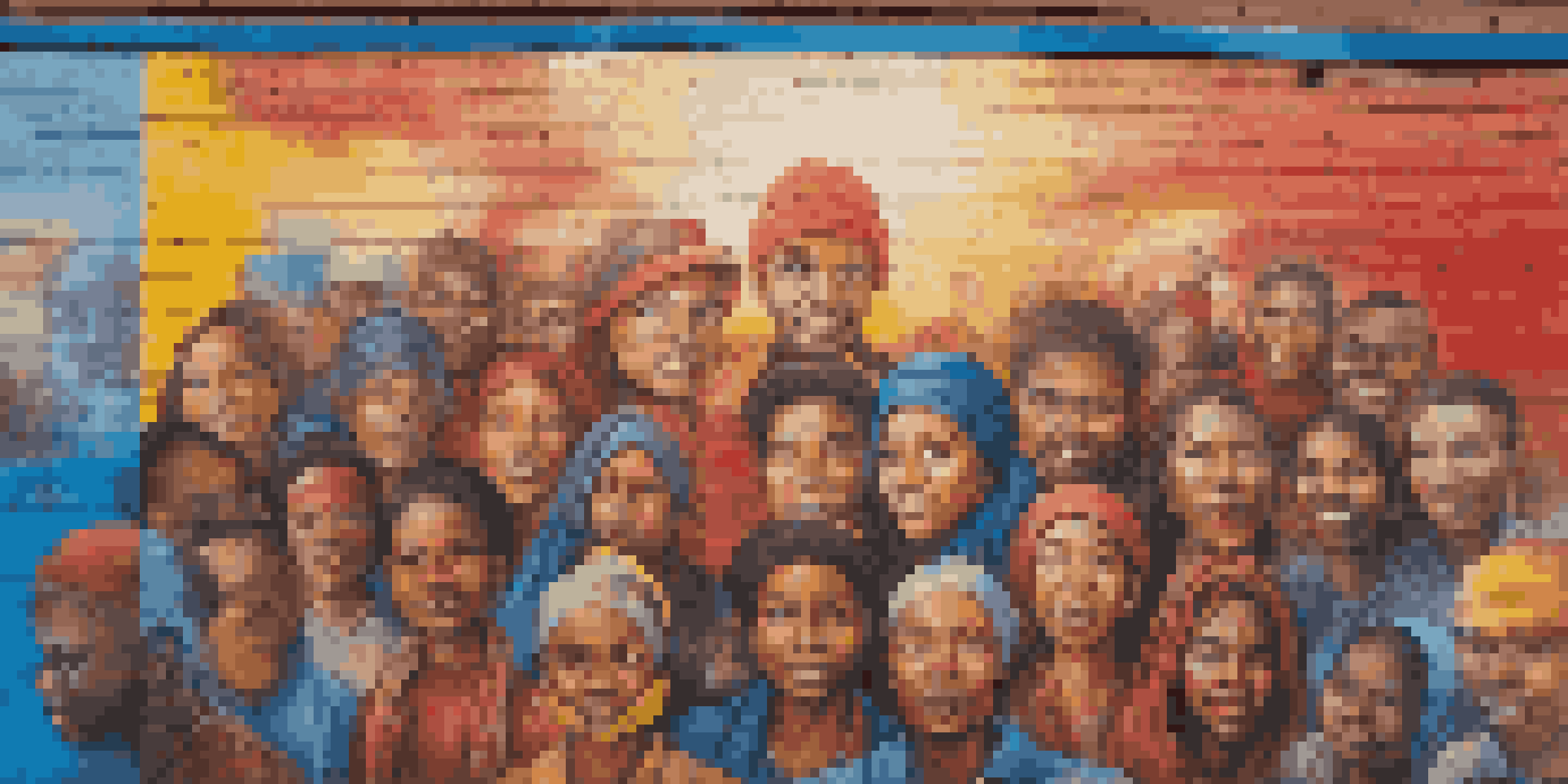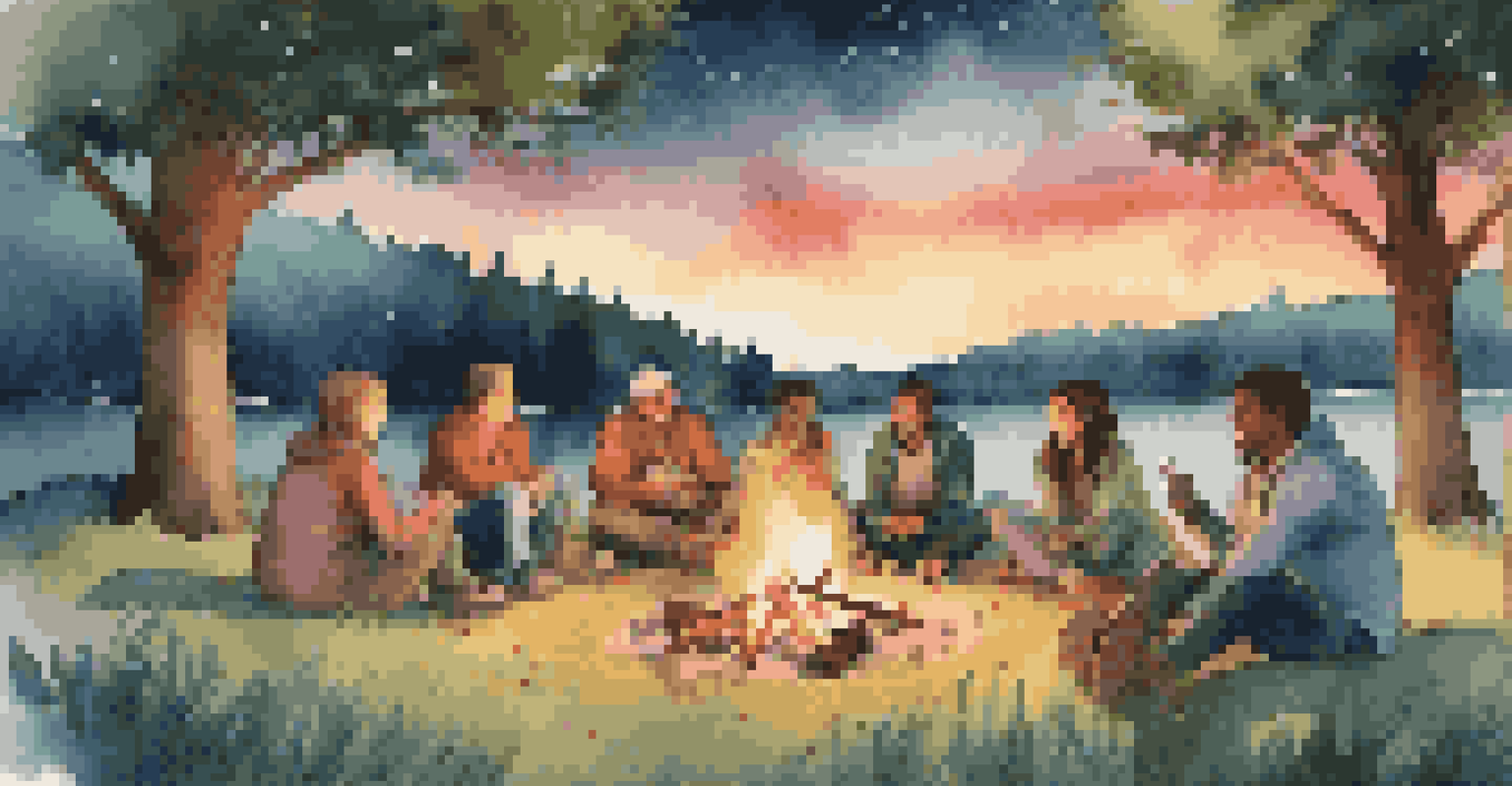The Role of Art in Healing Political Trauma and Social Division

Understanding Political Trauma and Social Division
Political trauma arises when individuals or communities experience significant distress due to government actions or societal conflicts. This can manifest in various ways, from emotional pain to a sense of hopelessness. Social division, on the other hand, often follows, creating rifts within communities that can lead to polarization and discord.
Art enables us to find ourselves and lose ourselves at the same time.
When we think of trauma, we often picture physical pain, but emotional and psychological scars can be just as debilitating. Political trauma can leave people feeling isolated and unheard, making it difficult to engage in constructive dialogue. This is where art can step in as a powerful tool for expression and connection.
Art, in its many forms, serves as a universal language that transcends barriers. It can provide a safe space for individuals to share their stories, fostering empathy and understanding, which are crucial for healing and bridging divides.
Art as a Means of Expression in Times of Crisis
During periods of political unrest, many people turn to art to express their feelings and experiences. Whether it's through painting, music, or performance, these creative outlets allow individuals to convey complex emotions that might be difficult to articulate in words. This expression not only helps the artist but can resonate deeply with others who share similar feelings.

For example, street art often springs up in response to social injustices, turning public spaces into canvases of protest and hope. These powerful visuals can provoke thought and inspire action, encouraging communities to confront their challenges together. When people see their struggles reflected in art, it validates their experiences and fosters a sense of community.
Art Heals Political Trauma
Art serves as a powerful tool for individuals to express their emotions and foster connections in the face of political trauma.
Art can also serve as a form of catharsis, providing a release for pent-up emotions. This therapeutic aspect is crucial in helping individuals process their trauma and begin to heal, making art an invaluable resource in times of crisis.
Building Empathy Through Artistic Collaboration
Collaboration in the arts can bridge divides and foster empathy among diverse groups. When artists from different backgrounds come together, they create a space where differing perspectives are acknowledged and valued. This collaborative spirit can break down stereotypes and build understanding across cultural and political lines.
The role of the artist is to make the revolution irresistible.
Community art projects, for instance, can unite individuals around a common goal, encouraging teamwork and shared experiences. These initiatives often lead to deeper conversations about the issues affecting the community, promoting healing through dialogue. As participants engage in the creative process, they learn to see the world through each other’s eyes.
Moreover, collaborative art can create lasting memories and connections that extend beyond the project itself. When people work together to create something meaningful, they build relationships that can help heal the wounds of division and foster a sense of belonging.
The Role of Storytelling in Artistic Healing
Storytelling is a fundamental human experience, and when incorporated into art, it can be a powerful vehicle for healing. Artists often weave personal narratives into their work, allowing audiences to connect with their stories on a deeper level. This connection can be transformative, as it encourages listeners to reflect on their own experiences and emotions.
The act of sharing stories can also facilitate conversations around difficult topics. For example, theater productions that tackle political issues can invite audiences to engage in discussions about their feelings and opinions. This interactive element creates a safe environment for dialogue and understanding, breaking down barriers.
Collaboration Builds Empathy
Collaborative art projects unite diverse groups, creating spaces for understanding and healing through shared experiences.
Moreover, storytelling through art can help preserve cultural histories and identities, reminding communities of their shared struggles and resilience. By honoring these narratives, artists contribute to the healing process and promote a sense of unity among those affected by trauma.
Art as a Tool for Activism and Social Change
Art has long been a catalyst for social change, and its role in activism cannot be overstated. Artists use their platforms to raise awareness about pressing issues and inspire action, often sparking movements that address political trauma and social division. This intersection of art and activism empowers individuals to advocate for change in their communities.
For example, music has played a pivotal role in movements for civil rights and social justice, providing anthems that unite people in their struggles. These songs not only uplift spirits but also convey powerful messages that resonate across generations, reminding us that we are not alone in our fight for justice.
Moreover, visual art can serve as a form of protest, with powerful imagery that captures the essence of a movement. From posters to murals, these pieces can engage the public and provoke thought, encouraging people to reflect on their values and beliefs in relation to the issues at hand.
Creating Safe Spaces for Artistic Expression
Safe spaces for artistic expression are crucial for fostering creativity and healing. These environments allow individuals to explore their feelings without fear of judgment or backlash. By providing a supportive atmosphere, artists can delve into their experiences, creating work that speaks to the heart of political trauma and social division.
Art studios, community centers, and online platforms can serve as havens for individuals seeking to express their emotions. Workshops and classes that encourage creativity can empower participants to find their voice and share their stories. This process can be incredibly cathartic, enabling individuals to confront their trauma and find solace in their creativity.
Storytelling Fuels Healing
Incorporating storytelling into art transforms personal narratives into a collective healing experience, encouraging dialogue around difficult topics.
As these safe spaces flourish, they cultivate a sense of belonging and community among participants. This sense of connection can be integral to the healing process, helping individuals recognize that they are not alone in their struggles.
The Future of Art in Healing Societal Wounds
Looking ahead, the role of art in healing political trauma and social division is more relevant than ever. As societies continue to navigate complex issues, the need for creative expression and healing becomes paramount. Artists will play a vital role in shaping narratives and fostering dialogue that promotes understanding and unity.
Innovative approaches to art, such as digital media and interactive installations, are expanding the possibilities for how stories are told and experienced. These new mediums can engage broader audiences, inviting them to participate in the healing process. As technology evolves, so too does the potential for art to act as a bridge between divided communities.

Ultimately, the future of art in healing lies in collaboration and inclusivity. By embracing diverse voices and perspectives, we can cultivate a rich tapestry of artistic expression that not only reflects our shared experiences but also inspires hope and resilience in the face of adversity.